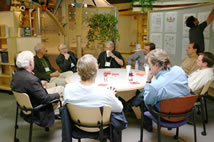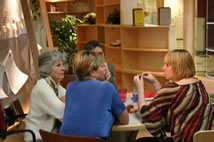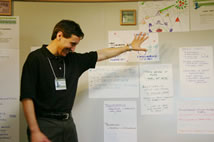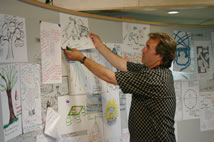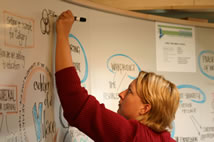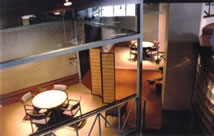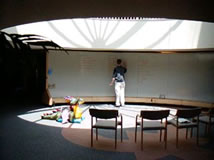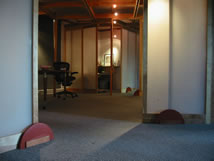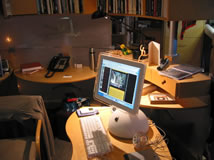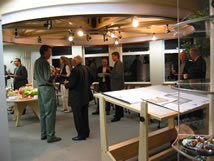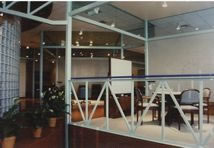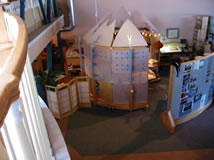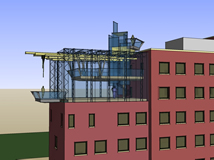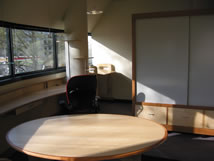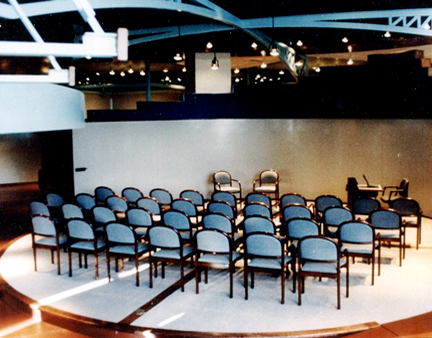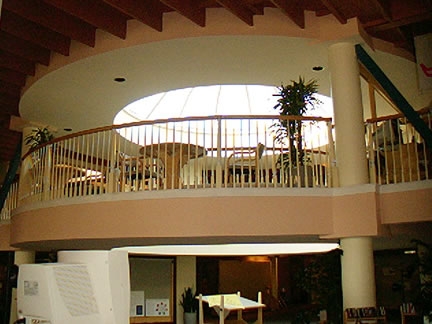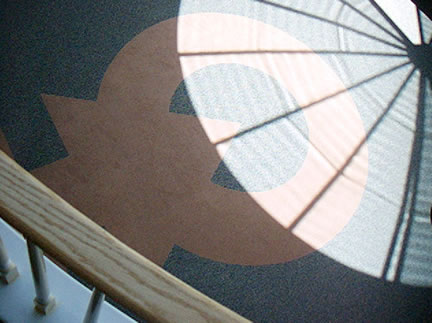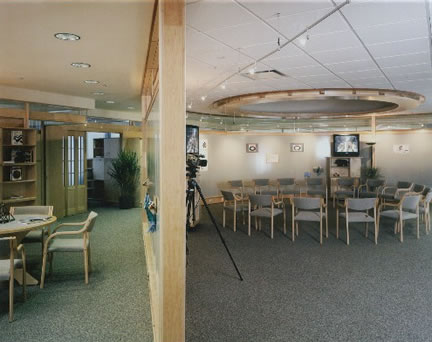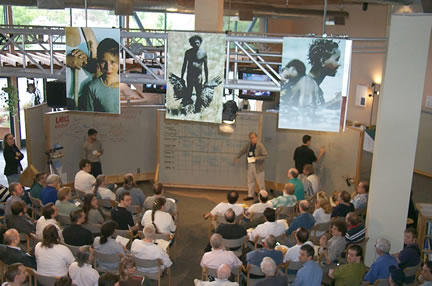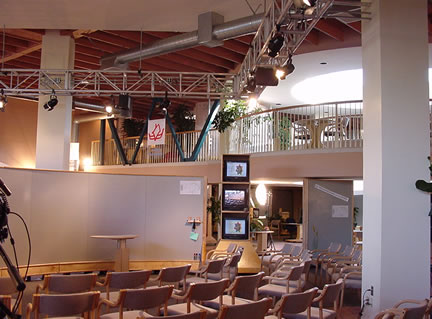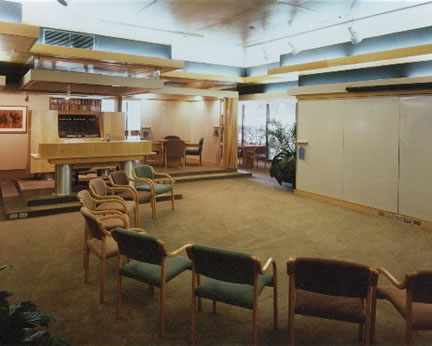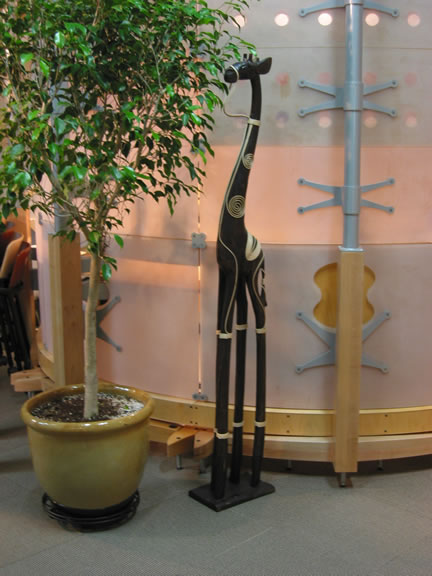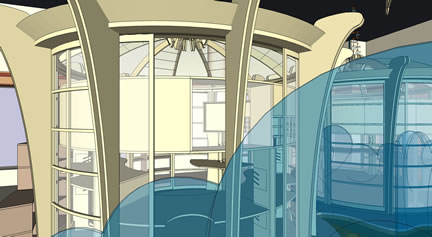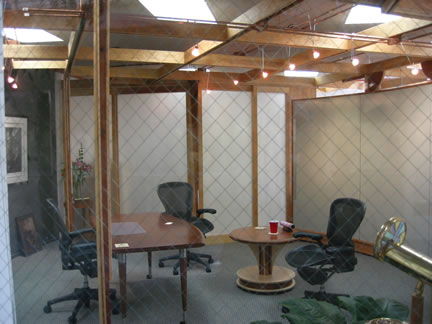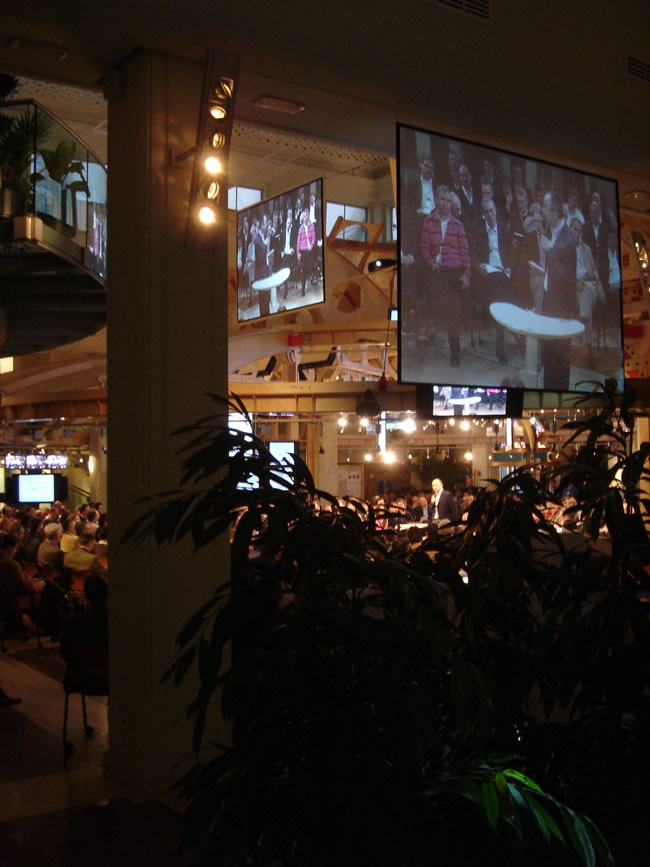A
Tour of Taylor Work Environments |
the
integration of physical space, a way of working and technology
augmentation |
•
for the story of each project and related material click on the
images •
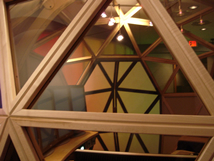
• click on picture (above) for updated slide show of tsmARCHITECURE work as of July 2009 •
|
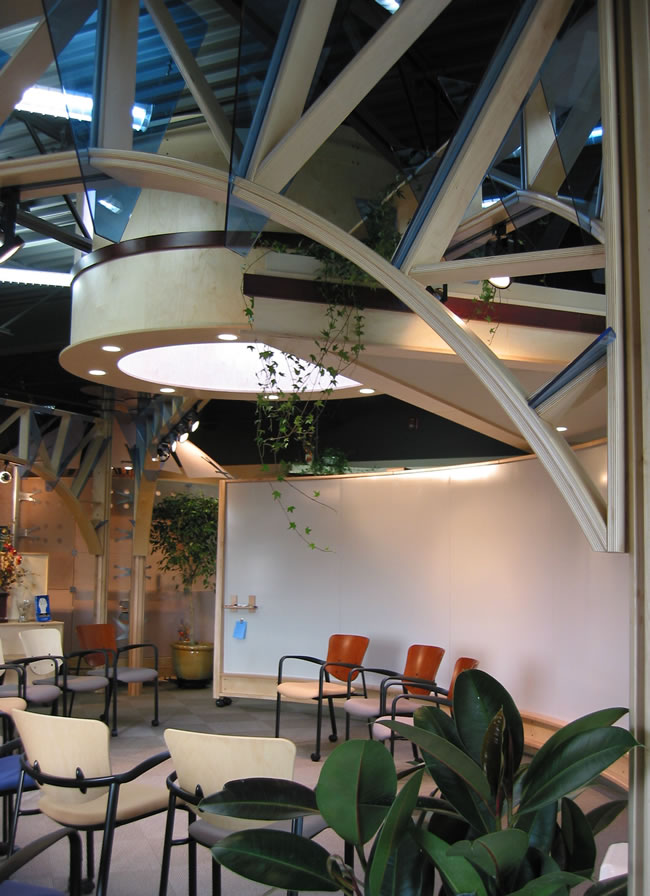 |
The
projects highlighted in this tour of MG Taylor
workplace architecture span exactly 20 years and
the US, Canada and Europe.
Throughout
this period, we have practiced continuity of principles
and pattern language in concert with continuous
innovation and aggressive development of means
and capability.
The oldest project shown
in this tour is still in operation in its fourth,
five-year lease cycle, without major alteration
or renovation,
despite the fact that four entirely different organizations
have employed it.
This
project (our first complete NavCenter by modern
definition) was entirely custom built; it took
6 months to complete
and was
expensive
for its
time.
It was flexible
and adaptable as all our environments are, yet
this came at a high cost. Our most recent project
is
entirely manufactured - it can be shipped anywhere
and set
up in a few
days and it can transform any “box,” large
enough to hold it, into a fully functional 21st
Century
workplace. Although about the same size, it cost
less than the original work and it is far more
flexible, adaptable and supports a much wider venue
of work modalities and technology augmentation
tools. This difference is the measure of the fruits
of
20 years
of rapid
prototyping as well as the advances that have been
made in technology.
Taylor
environments are meant to transform [link] the
work experience. They are based on a way of learning
and working that is natural
to knowledge workers in a networked economy. This
has been our purpose from the
mid-70s, when we developed the concept of MG Taylor.
For
over a quarter
of a century, we have designed, built and operated
environments to facilitate
hundreds
of organizations and thousands of their workers
through systemic change. This has
been our lab. By employing rapid prototyping, iterative
design-build-use, constantly informed by feedback,
we have compiled a body of knowledge about
the
relationship
between the environment and human innovation.
How people actually use work environments
to accomplish their goals is significantly different
than conventional wisdom teaches.
The
essence of a Taylor environment is the tight integration
between the physical place (which expresses all
the attributes of authentic architecture [link]),
the living and work processes (which are based
on complexity
and emergence as the norm [link])
and the tools (configured to augment human
collaboration and
creativity [link])
that
are employed. Our approach to integration is unique
and the method, upon which
it is based,
was
granted
a US patent in 2001.
Network
architecture is the basis of future organizations.
The work environment
has
to reflect this organization and support its way
of
working - which is fundamentally different from
hierarchy. Because architecture is the
expression of human values it cannot be faked.
We shape our
environments and in turn they shape us. How an
environment is made determines what it becomes.
At MG Taylor, we work in our own environments and
employ our processes to build environments for
others.
We
consider all stakeholders (investors, producers,
users) to be equal co-designers in every project.
We call this a ValueWeb [link].
The simplest statement of our work is that we make
virtual and physical
place in which people continually
transform their work, communities, organizations
and, thus, themselves.
The
typical work environment does not work well [link].
It does not support collaboration, particularly
of large groups which is essential when dealing
with complex systemic problems. It is not a healthy
place. In terms of total life-cycle economics,
it costs too much. It presents old symbols and
long
ago rejected
messages. It expresses and enforces worn out work
habits.
The
modern workplace is too often separated from the
communities it impacts most. Living and work are
bifurcated in the name of false efficiency. Isolation
dehumanizes people and leads to decisions, services
and “goods” that treat all
life as a commodity. To put life back into the
workplace
requires putting the workplace back into life.
People
spend 50% of their active years in the work environment.
Work has shifted from largely rote to the exercise
of applying knowledge to situations of ever increasing
complexity. The work environment has to be
where it is required to be and it must be configured
to support the work that is at hand - not be
where it was and
doing what it did - yesterday. People
have to be “at home” in their work
environment - able
to learn, able to work as knowledge creators
and collaborators. The work environment should
have the variety
of nature, the efficiently of a factory, the
comfort of a home, the stimulus of a great
city, sanctity of a library, the display capability
of an art gallery, the fun of a toy store,
the media of the best of theaters, the landscape
of a nature park, the fluidity of a wagon train,
the sense of play of a theme park, the resources
of an
university, and the technology integration
of a ship. And, it can. Not to do this is to
deny the human - short change the potential
in people, and to subvert the power of organizations
to do good and to be profitable as a consequence
of their ability to enhance human lives.
This
integration is achieved by removing the barriers
between design, engineering, building and use.
It is achieved by creating the work place
- the physical, the processes, the tool kit - to
be a single
eco-system
which is dynamic, alive and constantly evolving.
It is achieved by making the workplace a work of
art. |
|
|
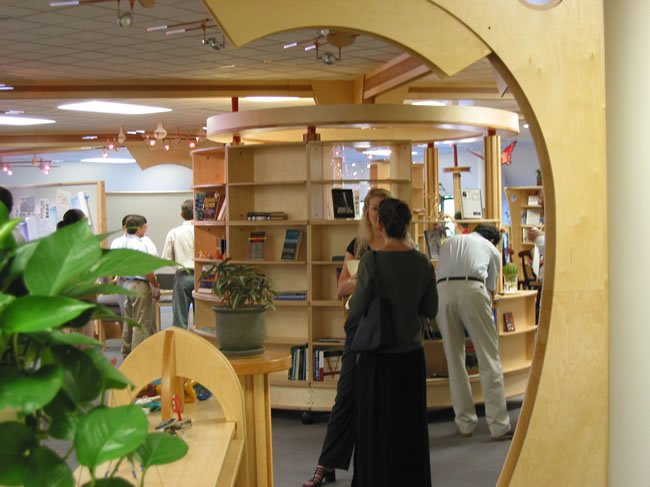 |
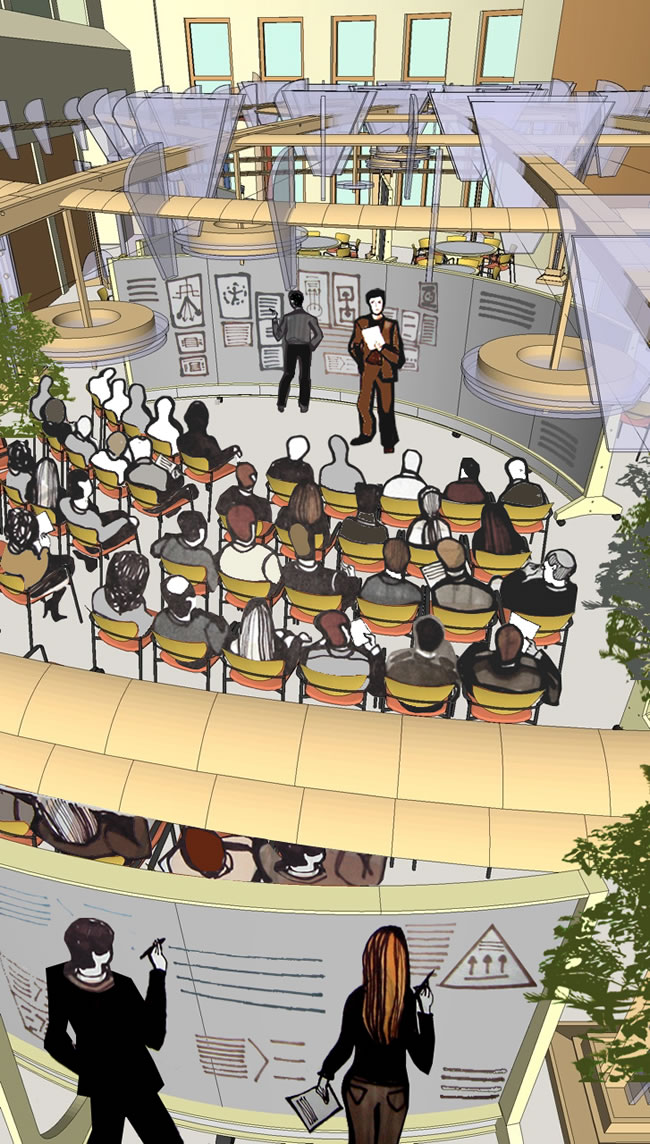 |
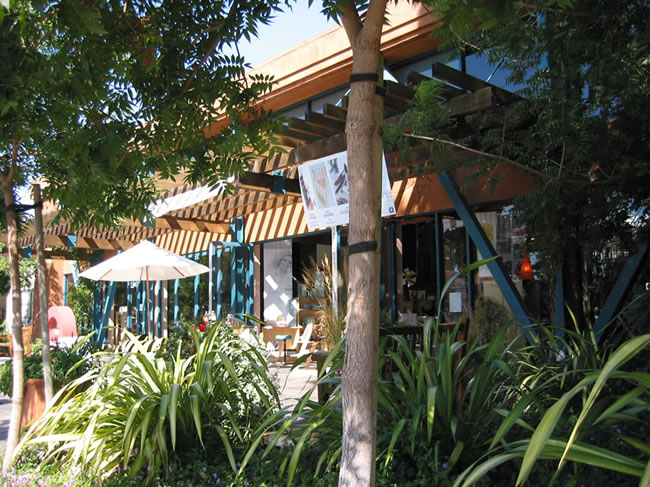 |
At
MG Taylor we
use natural materials to build our environments
for a variety of reasons. They are renewable.
They
recycle easier. They age and repair more gracefully.
There is an easy affinity with them. There
are thousands of years of long accepted design
and craft grammar associated
with these materials and this provides an anchor
for people even as so much else is new.
Every
region of the world has traditional patterns
that possess great social memory. Manufacturing
does not have to obliterate these connections.
The typical work environment, once you are
in it, becomes a bland place with
no signature nor sense of locality. The
manufacture’s brand overwhelms local
geography, the brand of the organization
and the personal esthetics of
its people.
Mass customization and lean-production methods,
if applied correctly, can promote a blend of
universal and local design attributes which
can counteract
this
whitewashing
of the human race.
Too
often the style-of-the-moment is proliferated
throughout the global workplace as the next-great-thing.
You may not know where you are in
your work environment
but you
can sure tell when it was made. The
built environment, other than some playful
things,
should not
be a creature
of
fashion with
“looks” that come and go like the
tides. Obsolescence should not be built in
- it should be built out.
Think of the VC Morris Shop, now 44 years old.
A retail store that old and not redone? Not needing to
be redone [link].
This is good economics. It helps in the
making of history and social memory. Build
well, build to last.
Make those things that have
to
change
easy to change.
Make the things that do not have to change
out of high quality materials that last
for a
lifetime. Make what is transitory out of materials
that can be easily recycled. This is the principle
of Armature [link].
As
work becomes global and virtual, materiality
is more important - not less. Every virtual
node on the World Wide Web is someplace.
Season, time of day and night, artifacts of
local distinction are important reminders of
both our common humanity, our communities and
the unique aspects of each of us. The individual
touch
that workers bring to their
personal environments, assuming that this is
possible, are a measure of their own comfort
and ability to
settle
in.
In many
corporations, this is prevented because it “spoils
the design and corporate look.” It is
interesting to think what message this
policy sends.
Architecture
that cannot stand the variety of those using
it is a weak attempt at best. Everyone deserves
and needs a place of
their own to work [link].
This personal place cannot be isolated from
collaborative and social spaces. Hard barriers
do not work well in this regard. A series
of graded transitions, controllable by those
being
effected by interaction, is the
requirement. Prospect and refuge is necessary
to human comfort.
The
great untapped resource in the typical workplace
is light. This is a health, comfort, work efficiency
and esthetic issue. Like so much of modern
life an engineering principle coupled with
false economics combine to make the fluorescent
glare
that is so common. |
|
|
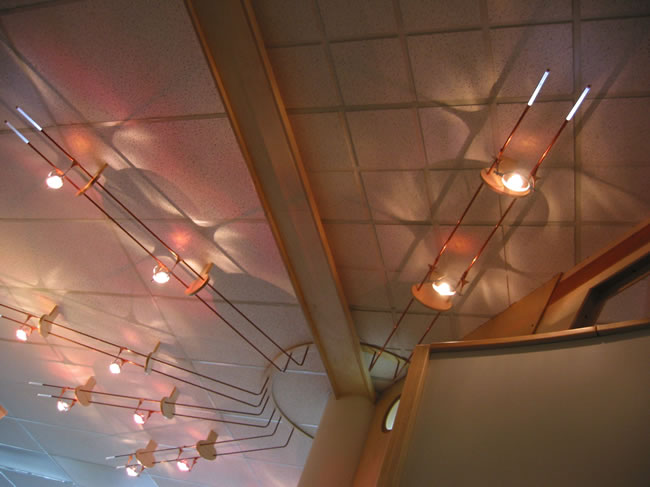 |
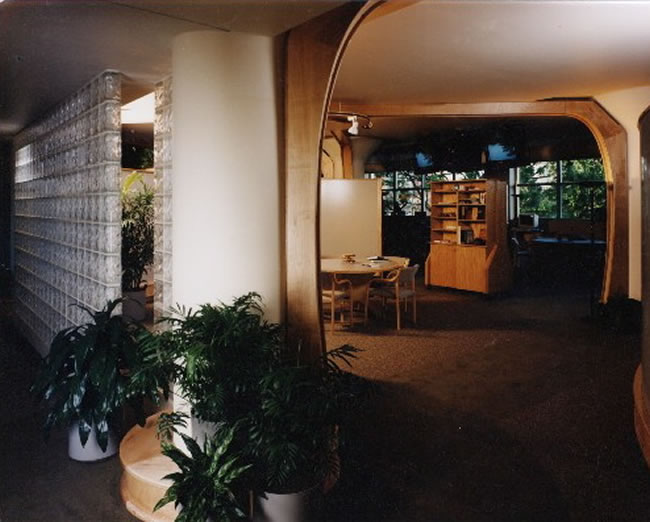 |
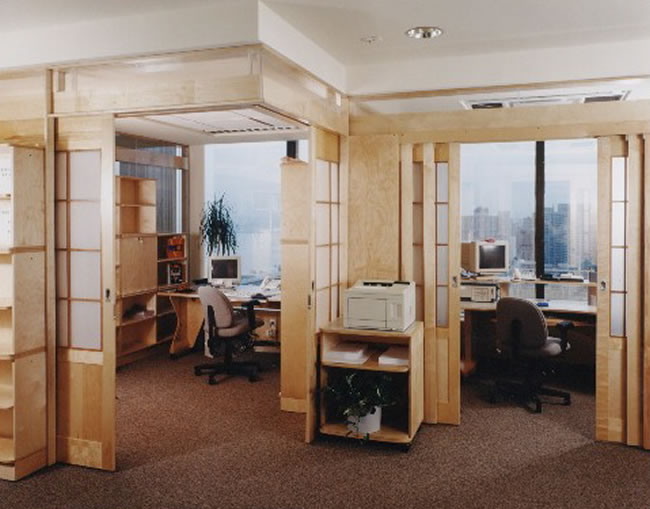 |
Full
spectrum lighting is necessary to physical
health. Also, moods are effected by lighting.
Glare,
primitive
computer screens, excessive sitting and small
cubicles
generate a series of health and attitudinal
problems - all in the name of economics. The
air quality of many building is poor - or worse.
Toxic materials are abundant. HVAC systems
tend to be loud and blow right at you dust,
germs
and
all.
Again, economical systems?
The consequences of these environmental factors
are not measured: dulled senses, productivity
loses, absenteeism and long term health care
costs.
Healthy
environments are good business. Heath requires
moving around, engaging in physical
activities, being mentally stimulated, employing
all the senses, being a valued part of a community.
The work environment not only must support
these factors, it should be organized so that
they
are demanded by the arrangement of the space
and the resources within it.
Different
work tasks require different work processes
which require different spaces. Because the
modern worker multi-tasks, it is not possible
to shape workplaces around singular, dedicated
work patterns. Because everyone has their own
preferences, it does not enhance productivity
to force people into standard solutions with
trivial options offered up as “choice” and “flexibility.” It
is not flexibility if an army of technicians
are required to reset the workplace. It has
to reset on-demand by those who use
it requiring little time, no esoteric skills
or specialized tooling.
Today,
most everyone has work that requires many different
modes of working.
Working alone, in small teams, in large groups.
Working with remote collaborators, traveling,
working at home. Working on projects that can
be held in a single laptop with wireless or
on projects so complex it takes a 40 foot wall
just to see the key factors and their relationships.
This requires using computers and media as
well as centuries old means of expressing ideas.
This
is a demanding
and rich workplace that is unfortunately truncated
by existing architecture rather than being
augmented by it.
The
appropriate environment for a knowledge-worker
is a “cybernetic forest” [link].
Human built environments can match this specification.
Achieving this requires giving up many of the
old design assumptions that dominate the workplace
today. It means moving from a workplace based
on real estate practices to making a
temple of work.
Architecture
is not about thing-ness it is about
spirit. Architecture that is appropriate [link] for
the workplace expresses the
spirit of the enterprise. It inspires. It facilitates
- to make easy - knowledge transactions
and work processes. It is the embodiment of
the principles and values of the enterprise.
It is memory of its history and practices.
It is BUILT philosophy.
|
|
|
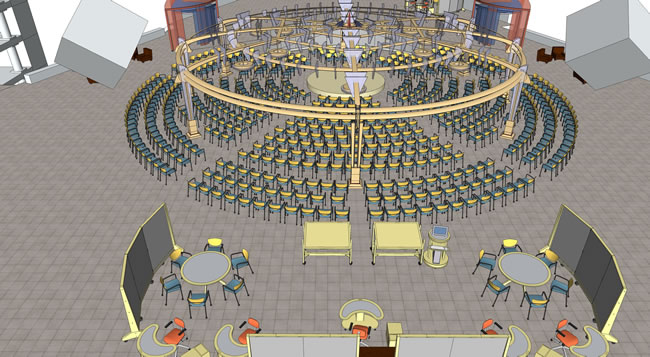 |
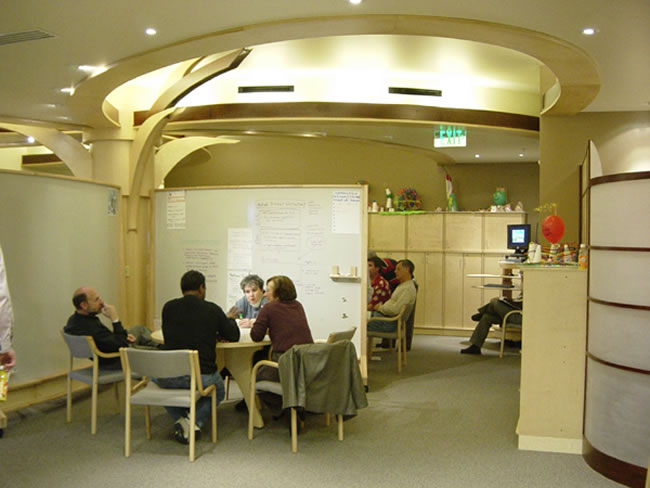 |
Architecture
is an art. It is only practical when it achieves
this status. Architecture shelters life, organizes
the space and utilities that supports life, and
it expresses life. Authentic architecture [link] is
as natural a place to be in as a forest. It is
a place
of fresh air, gentle breezes and light. It is made
up of shade and shadow, prospect and refuge, hot
social areas and quite places for retreat, study,
thought and contemplation.
The living and work processes that take place within
it are supported in specific and
concrete ways. This means on a finite level not
as a gross generality.
Its energy and material life-cycles support sustainable
environmental processes;
it
is not made up of
sick
buildings that make people ill, over consume energy
and pollute the Earth.
An
authentic architecture expresses
place. It is somewhere and you
know it. It expresses the special essence of its
region, community
and that of the enterprise which it houses. It presents
a viewpoint, a way of seeing reality [link].
It provides the experience of this sense
of reality and life.
A
proper work environment does what all
architecture does and it earns
its living. It does so by facilitating human creativity
and production. It does so by projecting the
BRAND of the organization as a powerful
message to employees, customers and public. It
supports
the economy of an enterprise by being economical
not by being the consequence of short term, budget-driven
compromises. All things being
equal, a work of architecture makes more money
than a mere building - as S.C.Johnson discovered.
H.F. Johnson Jr., who built the Johnson Administration
building with Frank Lloyd
Wright, claimed it paid for itself in a matter
of a few years. This environment is lovingly maintained
to this day, nearly 70 years later, as both symbol
and
home of the company [link].
Architecture
is not a visual art. It is an experiential art.
You move through it and every aspect of the environment
speaks. Nothing is accidental and the subject of
this art is the people who live and work within
it and their way of doing so. These
messages come by many senses: sight, texture,
sound, smell,
touch, movement
and
provoke
many
intelligences: kinesthetic, proximity, emotional,
conceptual, tactile. All these are in different
weight and combination for each person yet
they add up for all as a gestalt that is unmistakable
in essence and fidelity. The ubiquity of
human made building is such that it is
becoming
the major environmental factor we are
co-evolving with. This makes the character
and quality
of our
architecture more critical than in the past.
Next
to architecture, and aside from direct human interaction
itself, the greatest human-made influence on people
is media.
When architecture
and media
are combined the result is powerful. The modern
workplace is becoming, by necessity, the greatest
exponent of this combination.
All
forms of media are multimedia from paper and pen
to graphic workstations and multi-array displays
expressed in print, sound, video/film or tactile
means. Each form
of media, and every kind of expression of it,
has some elements it does best. Each of
us has an
unique
profile of learning and creating
with our own individual requirements for tooling.
The work environment can and must accommodate this
variety. It does not come close to doing so today.
Everything
in the work environment speaks
including the physical structure itself.
Media conveys information, it challenges and stimulates
thinking and it is one form of memory. The
entire environment is memory of what has gone
before.
It is the true signature
of
an enterprise - not because you hang a sign
on it -
it is so because architecture is the enterprise’s
values built large. You can try and tell
someone
what
you are but
let them
come into your house and they can see for
themselves.
There
are many different kinds of work and each
kind must be supported according to its specific
nature not according to some generalized abstraction
of
work processes. Working surfaces, tool configuration
and accessibility, displays, room sizes, light
levels, the number of people involved in a task,
work cycle duration, work activity pace - all are
variables that demand distinct and direct architectural
support. In the typical work environment this does
not happen with anywhere near the granularity required
by the work.
The
use of computers and media in the workplace today
is still primitive. These tools are now largely
used to amplify what are 19th century methods.
The fact that computer keyboard layout followed
the typewriter which was designed to slow down
typing
because of the slow response of early machines,
is a fitting metaphor for a broad set of examples.
The argument, when electric typewriters came out
and eliminated the speed problem was that the
installed base was too large and a change would
be too disruptive. Compare the number of keyboard
users today to that of the 1960s and the absurdity
of this argument is revealed. This is but one example.
Now, workers are being asked to understand immensely
complex relationships through the footprint of
a small screen (or small pages of print) usually
statically displayed while often having to do this
in a shared
way.
Even
with recent advances
this
is
impossible.
All technologies have strengths and weaknesses.
Each has an epistemology in embedded form. Each
reveals some things and hides others. Thus, every
technology has a bias.
These
factors of technology are inescapable. The configuration
of the technology tool kit and how this is intimately
linked to interaction protocols, worker rules-of-engagement
and work processes can not only mitigate these
disadvantages, they can turn them to advantage.
Taylor work environments have anticipated these
factors from our beginning and
have prototyped alternative tooling applications
designed to do so. Our approach to technology
has been to insist that it be transparent - never
getting between the knowledge worker and the work
or other knowledge workers. We have introduced
technology into our environments only at the rate
that the
users can understand and maintain it themselves.
Even so, we have pushed technology to its limits
bringing our vision “to here” at every
opportunity.
In
balance, MG Taylor physical environments and work
processes have advanced closer to our vision than
has our
technology applications. This is so for two reasons.
The relative immaturity of the technology and the
high cost of it. Recent advances are rapidly improving
these factors. Even so (and this is also true for
the environments we have build for our own use),
the part of the budget that gets cut consistently
is for media and its integration and use between
work sites. We are just beginning to realize the
many technology techniques illustrated on our 1982
“THERE”
graphic [link].
I
do not believe that we humans can be requisite
with the complexity and rate of change in our world
if we do not employ advanced media techniques
in everyday work situations. Look at what a movie
can convey in three minutes and compare it to a
typical dialog in the workplace. There is no
comparison. Simulations, in the near future, will
be standard research, planning and design tools.
We have been regularly employing them in our environments
for the last 15 years with outstanding results.
The integration of computer support and human enacted
simulations is still immature. The costs are too
high. The ability to draw from past experiences
and incorporate prior work in real time with new
simulations is still a dream. The next few years
will witness great advances in this arena. The
impact this will have on the physical environment
will be profound.
For
all these reasons the
time that it takes to make a work environment has
to be radically
reduced.
Today,
by the time
a design
is implemented it is often out of date. The
world and organizations, in response to it, are
constantly
changing; so should our architecture. Our ability
to build environment has to be requisite with our
need to have it and change it when necessary. Much
greater quality has to be accomplished at significantly
lower costs.
MG
Taylor practices architecture in a way designed
to improve these time, quality, cost factors. We
do design/build whenever possible. Our ValueWeb
Team is committed to a seamless integration between
design, engineering, fabrication, building and
the use of the product of this collaboration. We
seek long term relationships built on trust and
proven
performance.
We believe
in transparency in accounting across the entire
ValueWeb and shared risks and rewards on the project
level.
We
have a shop that produces our own case work, Armature
elements and WorkFurniture. This enables rapid
prototyping and facilitates mass customization.
Our shop crew installs what they build and deploys
our RDS (portable) environments. This enhances
feedback between users and producers.
These
design/build methods were developed by me in the
1960s [link].
It was possible to cut 75% of the time and over
40% of the costs from what was already
thought
of as commodity level construction. It was possible
to do this and achieve a great increase in design
and construction quality. The world is far more
complex today and we are just
starting
to build a capacity based on this prior experience.
Then, it was a practice exercise in anticipation
of the kind of environments we are building today.
As
much
as conditions are different from the 1960s, the
principles remain the same and the opportunities
today are far greater.
It
is time for the Cathedral Builders [link] to
gather and begin work.
Matt
Taylor
Elsewhere
December 14, 2004
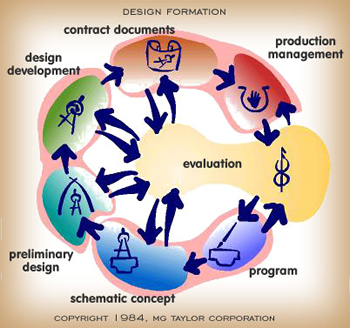
|
|
|
|
|
|
|
|
|
|
|
|
|
Projects
Illustrated: Orlando Management Center 1985 Matt Taylor
and Jim Toohey Orlando, Florida • Capital Holding
Management Center 1992 Matt Taylor, Don Weber, Langdon
Morris, Louisville
Kentucky • Cambridge knOwhere Store 1996 Matt Taylor,
Inga Hanks, Bill Blackburn, Brian Coffman, Cambridge
Massachusetts
• Palo Alto knOwhere Store 1997 Matt Taylor, Bill
Blackburn, Inga Hanks, Palo Alto California • Continuum
Health Care NavCenter and Offices 1999 Matt Taylor, Inga
Hanks, Bill
Blackburn, NYC New York • Joseki Offices 2002 Matt
Taylor and Scott Arenz, Menlo Park California • Vanderbilt
NavCenter 2002, 2004 Matt Taylor, Bill Blackburn, Nashville
Tennessee
• Cincinnati
VA NavCenter (concept) 2003 Matt Taylor and Scott Arenz,
Cincinnati
Ohio
• Salt Lake City VA NavCenter 2004 Bill Blackburn and Matt Taylor, Salt
Lake City
Utah •
Vanderbilt Children’s Hospital (concept) 2003 Matt Taylor, Bill Blackburn,
Jerry
Headly, Matt Fulvio, Nashville Tennessee • Bill Stead’s Office @
VCBH 2004 Bill
Blackburn and Matt Taylor • Master’s Academy and College NavCenter
2004, Matt Taylor, Bill Blackburn, Matt Fulvio, Jim Taipale, Scott Arenz • RDS
for WEF
and Club of Madrid, design 2004, deployment
2005, Bill Blackburn, Brian Ross, Dick Lowndes, Jerry Headly, Matt Fulvio, Scott
Arenz, Irina Sokolova, Matt Taylor, Andrea Guida, Rodney Meadows •
Additional
Credits: Don Penteldon, project manager for Cambridge
KnOwhere Store
construction and operations • Brian Ross, Director
of the AI Shop, fabrication of WorkFurniture and Armature
systems all projects excepting Orlando and Joseki Offices • Eric
Plankton, project manager and lead craftsman for Joseki
Offices supervising a team of SFIA students • Allan
Baker, field superintendent for Master’s NavCenter • Gail
Taylor, Mauirizio Travaglini, Patrick Frick, program development
for WEF and Club of Madrid RDS deployments
(scheduled for 2005) • Patsy Kahoe for logistics management 1993 through
present
• Lisa Piazza for business management and process transfer, Vanderbilt,
Salt Lake City and others, 1997 through present • Tim Siglin and Doug
Cantrell, multimedia engineering
• Paul Lyons, WorkPod design and various furniture
pieces 1997 - 1999 • Langdon
Morris, WorkFurniture development 1988 to 1992 • Bill
Blackburn, WorkFurniture and Armature development 1992
through present • Gail Taylor, co-developer of Taylor
IP and co-founder of MG Taylor 1979 to 2002 - now founder
of
TomorrowMakers, a non-profit employing the Taylor method • RK
Bruce, finacial management 1993 through present • |
|
posted:
December 14, 2004 • revised: December 17, 2004 and July 3, 2009 |
|
|
| Return
to MG Taylor Gateway |
|
|
|
|
| Between January 2006 through January 2007 the UniCredit NavCenter was designed. From mid-November, 2006 to January 29, 2007 the project was engineered, fabricated, shipped from Glasgow Kentucky to Turin, Italy, installed and opened for business. This is our most sophisticated environment built to date. It is not the end of our evolution. It is the beginning of our true work. It took 50 years of my work and over 25 years of MG Taylor’s to reach this basic expression of our ideas. The integration of environment, process and knowledge augmentation in this environment creates a potential which can take the Taylor System and Method practice to a whole new level. It will take some time for this potential to be realized. For details about this project, and the story of its development, click on the picture above. |
|

• click on picture (above) for updated slide show of tsmARCHITECURE work as of July 2009 •
|
|
|



